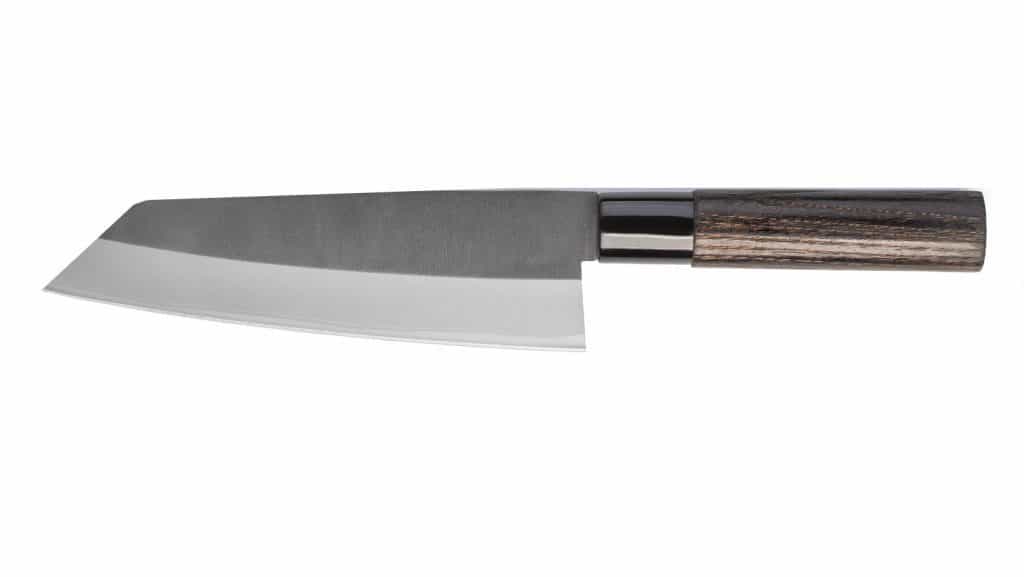Someone has got to stop me, I can’t stop collecting Japanese knives. One of the recent additions is the widely versatile Bunka knife.
The Bunka knife is a multi-functional Japanese knife that is similar to the widely popular Santoku knife but with a pointed ‘reverse tanto’ tip rather than a curved tip.
But, what is a Bunka knife actually used for?
Designed for versatility, you can actually use the Bunka knife for a range of everyday kitchen tasks. Its straight, sloping curved edge makes it excellent for chopping and cutting, and its pointed tip makes it quite effective at piercing and precision slicing.
Let’s take a full-blown look at the Bunka knife, what you can use it for, and how to use it.
Bunka Knife History
Bunka translates to culture. The term “Bunka bōchō” literally means “cultural knife.”
The translation is true but the meaning is up to interpretation. Many people believe this means that the knife is made for making traditional Japanese cuisine in any home. Although this is certainly a fair thought, I believe it’s actually the other way around:
A Bunka knife brings traditional Japanese craftsmanship and culture into the modern world, no matter the kitchen’s cuisine, background, or location.
The Bunka knife was introduced In the late 1860s when the Edo rulers imposed food purity laws on Japan. In Japan, there was a knife for every purpose, which is why there are so many specialist knives that still have expert uses in the kitchen, such as the Nakiri knife for cutting vegetables, Deba Knife for raw fish, or Yanagiba knife for sashimi or sushi.
The Bunka knife was one of the earliest multi-use knives, similar to the Santoku knife or Gyuto knife, keeping the specialist knives for their tasks and using a separate more versatile knife for general purposes.
What Is A Bunka Knife?

Japanese knives can be single-beveled and double-beveled, referring to if they’ve been sharpened on one side, single-bevel, or both sides equally, double-bevel. Generally speaking, more of the traditional knives have a single bevel and more of the modern Japanese knives have a double bevel.
The Bunka is a double-beveled Japanese kitchen knife with a sharply angled tip. Despite its piercing appearance that resembles the traditional Katana, the Bunka knife is considered a modern knife.
Aside from slight variations between knives, the main difference between the Santoku and the Bunka is the shape of the blade tip. The Bunka has a reverse tanto tip rather than a curved sickle-shaped tip. Aside from this minor distinction, the Bunka has the same advantages in the kitchen as the Santoku.
Bunka knives come in a wide range of lengths, ranging from 120mm to 240mm. The most appropriate Bunka knife blade length for most people is around 165mm and is considered to be the most balanced and suited for many purposes.
Compared to Western knives like the chef knife, Japanese knives like the Bunka knife have tougher steel, are sharper, and have stunning craftsmanship from the blade to the Japanese handle.
What Is a Bunka Knife Used For?
Just like there are Japanese knives for filleting fish or Japanese knives for cutting vegetables, there are also general-purpose versatile knives used for everyday kitchen tasks.
Similar to the Western chef’s knife in use, the Bunka knife can be used for almost anything. Although it’s not specialized for each task, the Bunka knife can be used to cut vegetables, fruits, fish, meat, and other foods.
Its sharp tip makes it great for making precise cuts and puncturing vegetables or meats, and its long flat blade makes it easy and efficient at repeated slicing and chopping of foods. There is really no limit to what you can use it for. But, if the kitchen task does call for a specialist knife, like for deboning or chopping through bone then you’ll still need to consult your arsenal for a different tool for the task.
Most Bunka knives have a double-bevel blade, making them suitable for both right or left-handed people.
How To Use A Bunka Knife
Bunka knives have an all-purpose, tall blade that makes them ideal for push-pull cutting tasks.
See the below video for a great demonstration:
The sharp triangular sudden tip design comes in handy for more detailed and precise jobs, like chopping meat or fish. The flat shape also makes it more suitable for tap-chopping tasks rather than using a rocking motion.
Wrapping Up
The Bunka knife is a multi-purpose modern Japanese knife, perfect as a traditional and badass substitute for a chef’s knife or Santoku knife.
Bunka knives are ideal for chopping vegetables, meat, poultry, fruits, and much more. Their reverse tanto shape gives the knives a dexterous tip and a distinct appearance. Thanks to their blade design, they’re considered perfect for push-cutting jobs, which is widely used in every cuisine.
Because it’s so versatile you’ll be able to use it at every chance you get!

